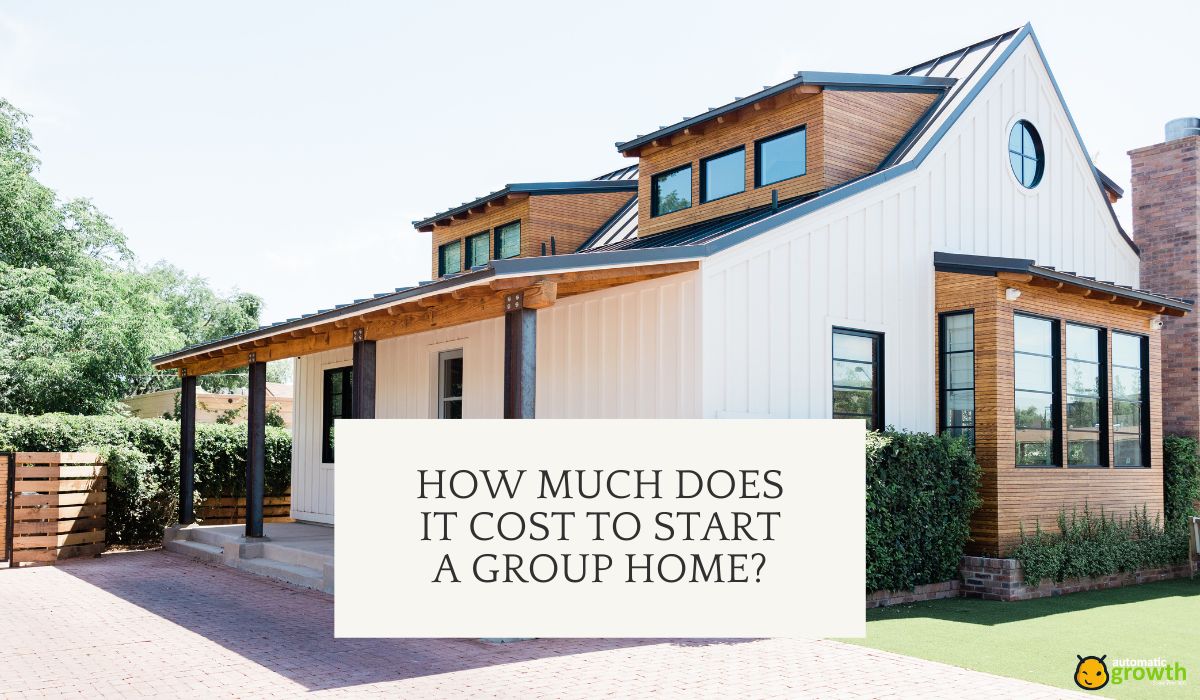Starting a group home is a commendable venture, offering support and care to those in need. However, before delving into this altruistic journey, it's essential to understand the financial implications. If you’re planning to open a group home facility, you might be wondering: How much does it cost to start a group home?
From acquiring the right property to ensuring it meets specific regulations to staffing and operational costs, the financial cost of a business venture is vast. In this guide, we'll provide a comprehensive breakdown of the expenses of starting a group home, ensuring you're well-equipped to make informed decisions. But first, let’s explore the business model of a group home.
What is a Group Home?
A group home operates at the intersection of healthcare, social services, and residential living. While the mission is often grounded in compassion and care, understanding its business model is essential to ensure sustainability and effective service delivery.
Group homes can cater to various populations, including those with developmental or physical disabilities, mental health challenges, youth in foster care, or individuals undergoing substance abuse recovery. Typically, residents in assisted living homes share living spaces, and the home is staffed with professionals or caregivers who oversee their well-being.
Recent studies indicate that residential care homes earn over $6,000 annually per resident before taxes. With an increased number of residents, the potential for significant profit rises. Group homes generate revenue through a combination of private payments from residents or their families, government subsidies, and, in some cases, charitable donations or grants.
Average Cost of Opening a Group Home
While a group home is a lucrative business, it also requires a significant investment. So, how much does it cost to start a group home? While there’s no one-size-fits-all answer to this question, we can refer to the market average costs to get an idea.
Opening a 6-bed group home entails substantial initial and recurring expenses. Thoughtful planning and commitment are crucial for funding. A startup cost of around $400,000 is anticipated for property acquisition, remodeling, furnishings, licensing, and insurance. Moreover, yearly operational costs, including staff salaries, administration, food, supplies, and activities, can exceed $350,000.
Breaking Down the Costs of Opening a Group Home
Although pinpointing an exact figure for starting an assisted living facility can be challenging due to various unique factors, there are some of the primary expenses you should consider. Let’s take a closer look at the expenses of opening a group home.
1. Location
Securing a suitable property will be among your most substantial investments. The key is to choose a space that can safely house your intended number of residents and is strategically located. Some opt to purchase land and construct a purpose-built residential assisted living (RAL) facility, while others buy a spacious single-family residence and adapt it for seniors' requirements.
A suitable benchmark is a 2,000 sq ft home with 3-4 bedrooms and 2 bathrooms, designed for 4-6 residents. In a typical U.S. locale, such a property might range from $250,000 to $350,000. However, in pricier regions like Southern California, prices can surge beyond $600,000. If purchasing isn't feasible, rentals might be a more budget-friendly option, averaging $3,000 to $4,000 per month.
2. Renovation
To ensure the property adheres to necessary standards and offers a comfortable living environment, renovation and improvement expenses can range from $10,000 to $100,000. Additionally, furnishings and equipment, including beds, kitchen appliances, safety tools, and recreational facilities, can cost between $5,000 to $20,000.
3. Furniture and Specialized Equipment
Equipping your facility with basics like beds, dressers, and seating is crucial. Additionally, you might need adapted tools, such as wheelchairs or walkers, for residents with mobility challenges. Initial expenses for furniture, appliances, and other necessities can range from $8,000 to $12,000.
Consider sourcing items from thrift stores or requesting donations via your online platforms. Monthly recurring expenses for essentials like food and activities are estimated to be between $1,000 and $2,000.
4. Business License
Securing the necessary business licenses and permits from state and local authorities is imperative. Keep in mind that these requirements can differ across states. Investigate local zoning regulations and acquire the official care home license. Typically, business licensing fees range between $500 and $2,000, while safety inspections might set you back $300-$600. The entire licensing journey can span from 2 to 6 months.
5. Staffing
Recruiting a dedicated team to cater to your residents is vital, encompassing caregivers, management, aides, culinary staff, and cleaning personnel. Staffing expenses will fluctuate based on the care intensity needed. For continuous, 24/7 care, anticipate an annual budget of $250,000 to over $400,000. With a rate of $15 per hour for a trio of alternating staff, you can project:
-
$90,000 yearly for a single shift
-
$180,000 for dual shifts
-
$270,000 for three shifts
6. Insurance
A comprehensive insurance for group homes is a non-negotiable aspect of operations. Primary liability insurance, which offers protection against potential lawsuits or claims arising from accidents, injuries, or negligence within the facility, typically ranges between $3,000 and $8,000 annually.
In addition to the foundational liability coverage, it's prudent to consider medical transportation insurance. This covers any risks or liabilities associated with transporting residents, whether for medical appointments or other outings, and usually costs between $1,500 and $4,000 each year.
7. Administrative and Operational Costs
Setting aside $15,000-$25,000 for administrative expenses is prudent for any group home venture. Here's a concise breakdown of those costs:
-
Accounting: Efficient financial management is vital, including regular bookkeeping and tax filing.
-
Legal Fees: Ensure compliance with local regulations, address any legal challenges, and handle contracts and agreements.
-
Advertising: Effective advertising, from local ads to social media promotions, helps establish your presence in the community.
-
Supplies: This covers everyday necessities, from office stationery to essential tools for resident care.
-
Training: Continuous training ensures your staff provides top-notch care and can handle emergencies.
Moreover, the daily operation of the group home includes:
-
Utilities: Regular bills like water, electricity, and heating.
-
Food: Providing nutritious meals for residents.
-
Activities: Recreational and therapeutic sessions for residents' well-being.
-
Transportation: Conveyance for residents, be it for medical check-ups or outings.
-
Operational Overheads: Miscellaneous daily expenses, including maintenance and repair.
Can the Government Finance Your Group Home Startup Costs?
Absolutely, though they might not foot the entire bill. On the bright side, various governmental tiers offer financial backing to those keen on initiating a group home. This assistance manifests as grants, subsidized loans, or even periodic subsidies. Notably, entities like the U.S. Department of Health and Human Services (HHS) frequently extend grants for group homes catering to niche segments, including individuals with disabilities or vulnerable youth.
Statewise, the financial impetus usually emanates from the Departments of Human Services, Social Services, or their equivalents. On the local administrative front, you might encounter perks such as tax deductions or favorable zoning provisions.
Tips to Maximize Your Group Home’s Profitability
Here are essential guidelines to ensure a thriving senior housing venture:
-
Research Thoroughly: Delve deep into the senior housing sector before embarking on your journey. Familiarize yourself with the industry demand, operational costs, and pertinent regulations.
-
Develop a Comprehensive Business Plan: Your business plan acts as a compass, detailing your objectives, tactics, and the steps to realize them.
-
Secure Sufficient Funding: Establishing a senior housing enterprise can be capital-intensive. Ensure you have ample financing for infrastructure, promotion, and daily operations.
-
Assemble a Robust Team: The backbone of a prosperous senior housing business is a dedicated team. Prioritize hiring adept personnel and cultivate partnerships within the industry.
-
Implement Effective Marketing Strategies: Once operational, actively promote your facility to potential clients and their kin. Employ a blend of advertising, public relations, and organic word-of-mouth promotions.
-
Prioritize Top-Notch Care: The cornerstone of your business's reputation is the superior care you offer residents. This encompasses premier medical services, wholesome meals, and fostering a safe, nurturing environment.
Frequently Asked Questions
What is the average initial investment for starting a group home?
The initial investment can range from $400,000 to $600,000, considering property purchase, renovations, licensing, insurance, and other setup costs.
Does location impact the cost of starting a group home?
Yes, property prices vary widely depending on the location. Properties in high-cost areas can be significantly pricier than those in average U.S. towns.
Are there recurring expenses after the initial setup?
Absolutely. Ongoing expenses include staffing, utilities, food, activities, transportation, administrative costs, and other operational outlays.
How much should I budget for renovations and upgrades?
Renovation costs can span from $10,000 to $100,000, depending on the state of the acquired property and the modifications required.
What about furnishing and specialized equipment costs?
For furniture, appliances, linens, and other essentials, expect to spend between $8,000 and $12,000. Additional specialized equipment for residents can adjust this figure.
Starting a group home is not just an endeavor of compassion but also a significant financial investment. While the costs might seem overwhelming—from property acquisition and renovations to staffing and administrative expenses—it's essential to remember the profound societal value these homes bring. With governments at various levels offering financial assistance, there are avenues to lighten the financial burden.
Speaking of investments with both societal and personal rewards, have you ever considered the health and fitness sector? The demand for fitness facilities continues to rise. If you're curious about diving into this thriving industry, let's explore the costs of opening a gym. Stay informed!
















